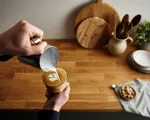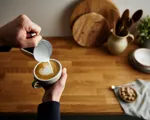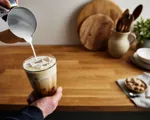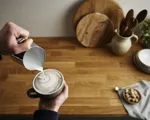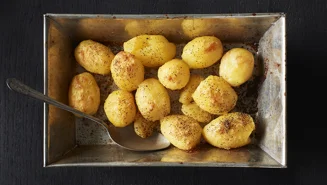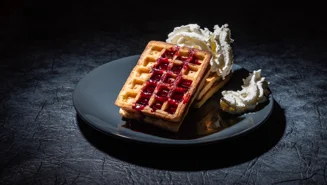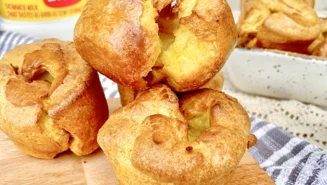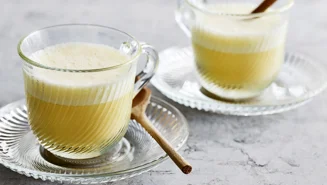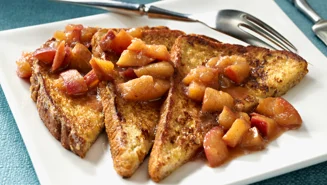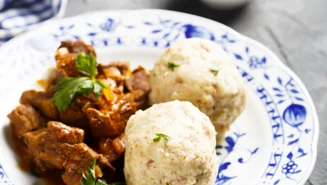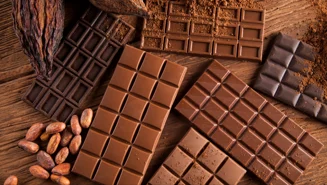
Create a fabulous flat white at home with our easy flat white recipe and expert barista tips.
Flat White Key Ingredients:
- Espresso coffee
- Arla Barista milk
- Sugar, syrup or sweetener
Equipment needed:
- Coffee machine
- Milk jug
- Thermometer
- Mug
- Spoon or stirrer
Flat White Jargon Explained
- Tamped – The process of evening out your espresso grounds in the basket of your coffee machine. By evening them out as much as possible, you can get an even extraction and a tasty final result.
- Aerate – Adding micro-bubbles to your milk to increase its volume, for a silky smooth milk to add to your flat white.
- Steaming – Using steam to aerate and heat the milk to give it its silky texture.
- Ristretto – Translating to “restricted” in Italian, this means reducing the amount of water that flows through the coffee grinds. By restricting it in this way you make a shorter and stronger espresso.
- Dispense time – The time from the start of the brew to your espresso machine dispensing coffee. Dispense time affects the sweetness, acidity and bitterness of your espresso.
How To Make A Flat White At Home
Flat White Recipe Step-By-Step Method:
Step 1: Start your expresso machine
Fire up your espresso machine so it can begin preheating.
Step 2: A quick check
Check everything is clean and dry before you begin brewing. Look at the shower screen, the espresso basket and the spouts of your machine’s handles.
Step 3: Coffee in the espresso basket
Dose or grind your espresso coffee into the espresso basket. Make sure you evenly distribute it so it’s ready to be tamped down. You’ll need 7-10g of coffee for a single shot of espresso. For a double shot, use 14-20g of coffee.
Step 4: Tamp down
Use a tamper and press down evenly and firmly on the coffee bed to leave a flat, smooth surface.
Step 5: Start your brew
Brew your espresso shot as per your machine’s instructions. You need to consider dispense time at this stage. The right dispense time affects the acidity, sweetness and bitterness of your brew. Depending on the coffee you’re using you’ll likely find the ideal dispense time online from the coffee company. Most recipes tend to need a liquid dispensing time of around 25-30 seconds from when you push the button on your machine.
Step 6: Time for aeration
Steam your Arla Barista milk to get the ideal aeration. A flat white, as the name suggests, has much less foam than a cappuccino, as well as less milk than a latte. This means you want to keep the aeration to a minimum, only increasing the milk’s volume by a small amount. Hold the steam wand about 2cm into the milk, and keep the jug at an angle to allow the milk to swirl as it heats. It will make some noise, but it shouldn’t get too loud or screechy. If it does, insert the steam wand a little deeper into the milk. Aim to reach a temperature of 60-65C to finish the steaming process.
Step 7: Don’t wait to clean
Wipe down the steam wand as soon as you’ve finished to avoid any milk residue drying.
Step 8: Polish your milk
Next, you’ll need to polish your milk. Do so by swirling it and tapping it on the counter to burst any final larger bubbles. This will help you get that smooth, silky texture.
Step 9: Pour the milk into the liquid espresso
Make sure the milk hits the liquid espresso base within 20 seconds of finishing the steaming process. This means the milk won’t have time to degrade before being combined with the espresso.
Expert Tips For Your Flat White
Flat White Recommended Ristretto Count
The flat white is a drink that started simple and became a little more vague as the big coffee chains adopted and adapted the drink to suit their needs. In terms of differentiating the flat white from other popular coffee beverages, it is worth commenting on its double ristretto shot of 30-40g liquid, its silky, thinner foam and a cup size of 150-180ml. We recommend brewing 14-20g of ground coffee to hit the approximate standard and then playing within that range to find your own preferred flat white strength. The intensity of coffee flavour varies greatly between a 14g start and a 20g start with ground coffee, as does caffeine content. So, experiment with care!
Cup Size
The flat white circulated as a drink of small stature, found in a 5-6oz cup which converts to approximately 150-180ml in volume. You may find this to be larger in volume as you travel around many countries, likely due to the general trend of coffee businesses moving towards increased sizes no matter how a drink started.
Milk Aeration
In terms of the milk foam for a flat white, the aim is similar to a latte in the level of aeration. The goal is to create a milk that’s smooth and silky in texture with only a small amount of foam on top - hence the name flat white. This also means you can make latte art on top of your flat white if you want!
Flat White Ratio
A flat white is generally two parts coffee to three parts milk to one part foam. Foaming the milk for a flat white should be done carefully to minimise the amount of foam and keep the texture smooth and silky. A pro tip for flat whites is to use them as a great practice drink for latte art. Often, baristas find it easy to pour complex, layered designs with such a light milk foam.
Flat White FAQs
What is a flat white?
A flat white is a smaller coffee using less milk than a latte and with less foam than a cappuccino. You use either a single or double shot of espresso, with little to no foam. If you like a stronger espresso flavour, choose a flat white over a latte.
How much milk is in a flat white?
The perfect ratio of milk in a flat white alongside coffee and milk foam is three parts milk to two parts coffee and one part milk foam.
Is a flat white healthier than a latte?
In terms of calorie count, there is little difference between a flat white and a latte. It depends more on the type of milk you choose rather than the style of coffee.
